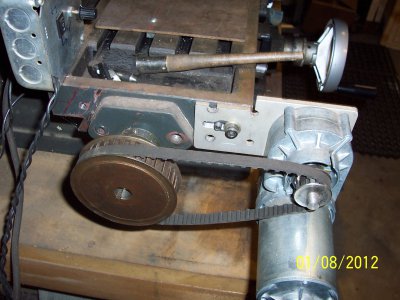Bob, my application is not a mill, but a carriage, mounted on a way. The carriage holds a block (for instance 1 by 1 1/4 by 10") of balsa. It is acted upon by a sanding roll spinning at 10,200 rpm. Two or three passes are required on each side to complete the operation. The carriage is rotated about it's horizontal axis by following a cam. I'm quite sure that a 1/3 hp motor geared down will operate it. It maximum speed is 7 inches in 30 seconds. That's a bit over one foot per minute. That's also as fast as I want to run it. Slower for deeper cuts.
I've been playing with mounting the motor, as I see it now the biggest problem I will have is determining the size of the pot to control the speed. I have a variable speed, reversible motor.
Should I be successful, I may well try to adapt the same process to the X and head of my PM25 mill.
Yes the 1/3 hp should be more than adequate for your needs.
Most variable speed controls for brush type motors in drills are electronic rather than simple pots. However, if it is a 120vac motor, a light dimmer should work. They also make speed controls for routers. A Variac or variable transformer will also work.
If it is a dc motor as in battery operated drill/driver type, then a pulse width modulated control is fairly easy to make. I have built them for motors up to 1 hp. A pulse width modulation circuit works by applying full voltage during a relatively high frequency cycle but varying the ratio of on time to off time.
The advantage of this over a pot is the lower power needed for the control circuit and higher torque at low speed. Switching transistors handle the current applied to the motor and are fairly efficient since the power lost is the product of voltage and current and during the off part of the cycle, the current is essentially zero while dropping the full voltage but during the on part of the cycle, the current is high and the voltage drop in the transistor is low. A simple pot works by dropping the voltage to the motor, dissipating the energy as heat.
I pulled apart an 18 volt HF type drill/driver. It has an electronic speed control (type JHKS-5E4), apparently fairly common in products of this type. As I recall, the maximum rpm was 500 and it had more than enough torque for your application. The beauty of this type of drill/driver is the motor and gear train are cylindrical which makes for easy mounting. The output shaft is a standard 3/8-24 thread, again fairly easy to couple to and the total length of the motor/gear train is about 5" and the diameter around 1.5". It has a variable clutch and as I recall, I paid $10 for it on sale at a local DIY store. HF is currently selling several for $17.
http://www.harborfreight.com/catalogsearch/result?q=drill+driver
If you wanted to run with a simple resistor for speed control, measure the current at full speed under load and divide the voltage by the current to get the effective resistance of the motor. As a first guess, that resistance in your pot would drop the voltage in half (not quite true). For a 1/3 hp motor, the current draw should be about 2 amps so the resistance would be 60 ohms. You will probably want to go to about 1/10th speed so the resistance should be considerably higher, possibly on the order of 300 ohms. Bear in mind that the pot must have a power rating to handle the current. Most high power pots or rheostats are wire wound and they are rated for maximum amps. You need to be able to handle 2 amps. This is a fairly hefty piece of hardware which is why they have gone to electronic controls.
Bob
Bob
Bob


